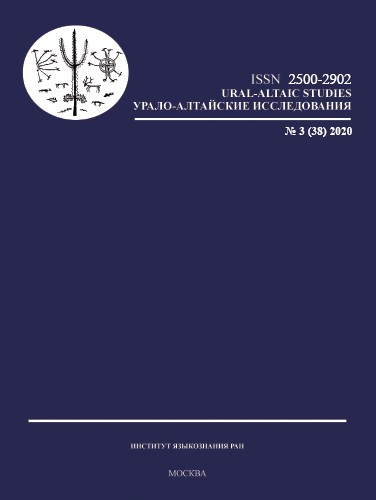Словари пермских манси «аборигенов Сибири», собранные П. С. Палласом в XVIII веке
Dictionaries of Perm Mansi “Native speakers of Siberia”, collected by P. S. Pallas in the 18th century
Author(s): Julia V. NormanskajaSubject(s): Phonetics / Phonology, Lexis, Historical Linguistics, Finno-Ugrian studies, 18th Century, 19th Century, Ethnic Minorities Studies
Published by: Институт языкознания Российской академии наук
Keywords: Mansi; Perm dialects; P. S. Pallas; achive data;
Summary/Abstract: As shown by J. Gulya, 18th-century Mansi dialects lacked the dialect traits which developed in the 19th—20th centuries and which have been described in detail by L. Honti. To the best of our knowledge, P. S. Pallas’s dictionaries of the Perm Mansi dialects have not been previously examined thoroughly from this point of view. This article identifies the place of the Perm Mansi dialects in the existing dialect classification. The analysis of the Perm Mansi dictionaries collected by P. S. Pallas allowed: 1) to refine the reconstruction of two PMans. phonemes: namely, the shape of the areas which preserve the reflexes a < PMans. *ā, ē̬ < PMans. *ī̮ indicates their innovative development. Thus, their PMans. forms should be reconstructed as *o and *ä instead; 2) to ascertain that two innovative developments in the Perm dialects are similar to the southern (Tavda) dialect: PMans. *o (*ā according to [Honti 1982]) > a, PMans. *u > o. However, the development of PMans. ɣ > 0, which takes place in the Perm Mansi dialects, is preserved only in the eastern and some of the western Mansi dialects, but not in the southern or northern dialects. In other cases, the Perm Mansi dialects preserve the archaic Proto-Mansi state. For instance, the Perm Mansi data make it possible to pinpoint the time of the PMans. change *u > o, which took place in the southern dialects. All in all, the analysis shows that the existing classification of the Mansi dialects describing their division, which took place about 1000 years ago, should be changed as it does not account sufficiently for the Perm dialects. According to this classification, some of the features place the Perm dialects into the southern Mansi group whereas other features identify these dialects as eastern or western. Furthermore, the article proposes that the development of PMans. *-ɣ should no longer be used as a criterion for classification since there is no PMans. reflex *-ɣ in all the northern Mansi texts of the 18th—19th centuries. Moreover, according to the field data, such a development is also present in the modern northern Middle Ob dialect. Thus, this feature does not divide genetically different dialect groups, but has an areal specificity. As for the other innovative features, the extinct Perm Mansi dialects are closest to the Tavdin dialect and should probably be assigned to this group. It becomes patent then that the currently extinct southern dialects extended almost 300 km westward to the Sverdlovsk region even as late as in the 18th century.
Journal: Урало-алтайские исследования
- Issue Year: 2020
- Issue No: 03 (38)
- Page Range: 71-80
- Page Count: 10
- Language: Russian

